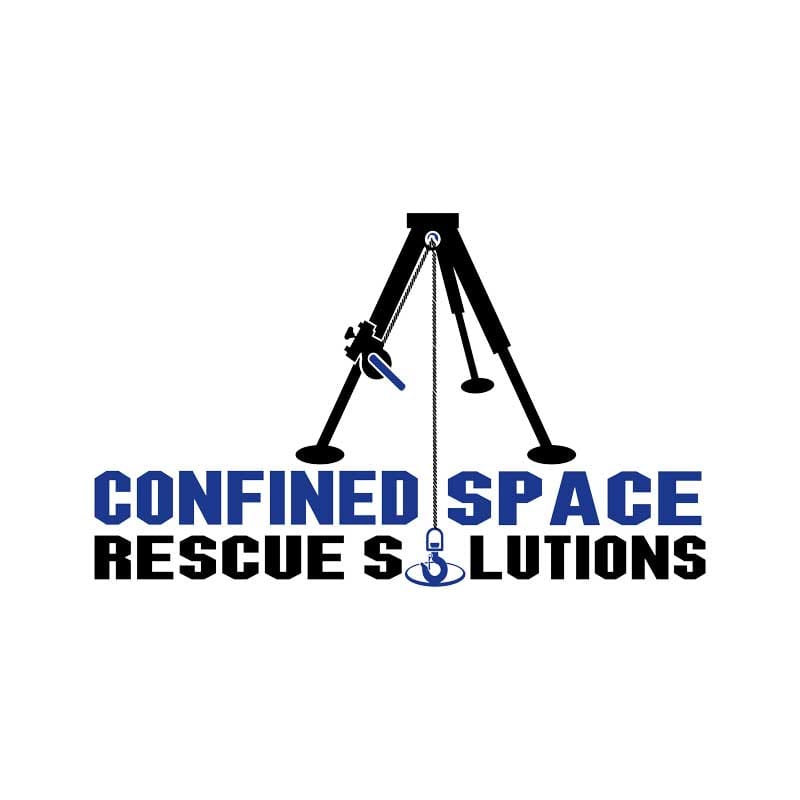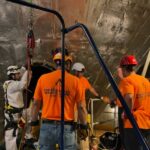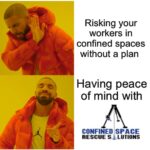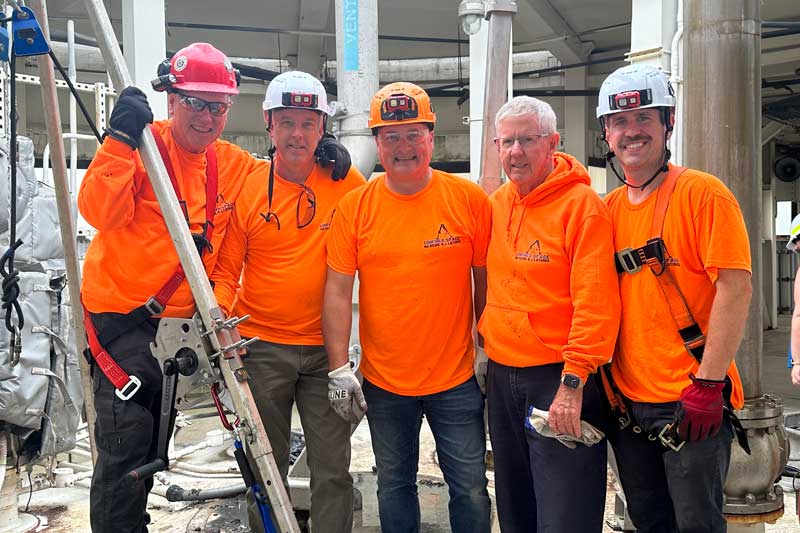Knowing and understanding the difference between the classification of confined spaces is vital for the safety of all involved, as it helps determine the proper precautions, training, and equipment needed to minimize hazards within the job site. A confined space refers to an area that is enclosed or partially enclosed and has limited access or egress, meaning it can be difficult to enter or exit. These spaces are typically not designed for continuous human occupancy, but workers may need to enter them to perform different tasks such as maintenance, inspection, or cleaning. Confined spaces can pose serious risks to workers who may need to enter them.
In the occupational safety world, confined spaces are typically divided into two main types: permit-required confined spaces (PRCS) and non-permit-required confined spaces (NPCRS). While both types share common characteristics, they differ greatly in the degree of risk they pose, and the safety measures required. Let’s dive deeper into these categories and understand the important differences between them.
- Permit-Required Confined Spaces (PRCS)
A permit-required confined space is a confined space that contains, or has the potential to contain one or more, hazards that could pose a risk to the worker entering it. The hazards in PRCS are not just limited to physical space constraints. PRCS often involve environmental or safety factors that can lead to serious injury or death if proper precautions are not taken. The Confined Space Rescue Solutions team is specialized and highly trained to look out and continuously monitor the below features and know how to react and rescue if any incidents arise.
Key Features of PRCS:
- Hazardous Atmospheres: The space may contain dangerous gases, fumes, vapors, or dust that could lead to asphyxiation, poisoning, or explosion within seconds.
- Engulfment Hazards: There may be materials in the confined space that can engulf or suffocate a worker, such as grain bins, silos, or tanks filled with liquids or loose solids.
- Inwardly Converging Walls: Some confined spaces have walls or structures that narrow as you enter, posing the risk of trapping or crushing a worker.
- Unanticipated Entrapment Risks: Workers may become stuck in the space due to its configuration, leading to serious injury or death.
Why is it “Permit-Required”? Due to the potential for dangerous conditions, entry into a permit-required confined space requires specific precautions. A confined space entry permit is required before anyone can enter. This is a permit that Confined Space Rescue Solutions can complete for your team. This permit includes detailed information about the hazards in the confined space, required safety measures, ventilation, emergency plans, and personnel involved in the entry. It ensures that workers are fully aware of the risks and that proper safety measures are taken.
Examples of PRCS:
- Storage tanks containing flammable materials.
- Manholes with unknown atmospheric conditions.
- Silos with accumulated grain or chemicals.
** The Occupational Safety and Health Administration (OSHA) regulates permit-required confined spaces (PRCS) under 29 CFR 1910.146. These regulations are designed to protect workers who are required to enter or work in confined spaces, ensuring they are aware of potential hazards and receive appropriate training and protective measures. **
- Non-Permit-Required Confined Spaces (NPCRS)
A non-permit-required confined space is still considered a confined space, but does not have the hazardous conditions that would classify it as a permit-required space. These spaces are generally safer to enter because they can lack or pose minimal danger to the worker. It is important to recognize, however, that the space can still present some degree of risk, and specific entry procedures and monitoring may still be required.
Key Features of NPCRS:
- No Hazardous Atmospheres: The space is free from toxic gases, vapors, fumes, or any other contaminants that could cause injury or death. It does not present a risk of suffocation or explosion.
- No Engulfment Hazards: There are no materials inside that could cause engulfment or entrapment, such as water, sand, or granular materials.
- No Physical Hazards: The space does not have dangers that could lead to injury.
Why is it “Non-Permit-Required”? Since the potential for harm is significantly lower, workers are not required to obtain a permit for entry. However, while these spaces might not require extensive safety measures, it is still crucial for workers to assess the environment, check for hazards before entry, and ensure that proper procedures are followed to avoid incidents or injuries.
Examples of NPCRS:
- A large, empty storage room without hazardous materials.
- A crawlspace with proper ventilation and no significant risk of entrapment.
- A dry, well-ventilated attic or basement.
** OSHA does regulate non-permit confined spaces, but the regulations are less stringent when compared to permit-required confined spaces (PRCS). Non-permit confined spaces still require employers to ensure certain safety measures, even though they are not subject to the full requirements of the permit system as such with PRCS. The regulations for non-permit confined spaces are primarily found under 29 CFR 1910.146. **
Key Differences Between PRCS & NPCRS
| Characteristic | Permit-Required Confined Space (PRCS) | Non-Permit-Required Confined Space (NPCRS) |
| Atmospheric Hazards | Potentially hazardous (toxic gases, low oxygen, etc.) | Safe atmosphere, no toxic gases or oxygen deficiency |
| Engulfment Hazards | Potential to occur (e.g., liquids, loose solids) | Not a risk |
| Inward Converging Walls | May be present (poses entrapment risk) | Not present |
| Permit Requirement | Yes, a permit is required | No permit required |
| Atmospheric Testing Required | Yes, mandatory | Not typically required |
| Risk of Entrapment | Potential to occur (e.g., tight spaces, machinery, configuration concerns) | Absent |
| Entry Requirements | Permit, extensive training, emergency plans, rescue equipment, monitoring equipment | Basic safety protocols |
Is it a PRCS or NPRCS? This Can Be Confusing…
Determining which category a confined space falls under can be difficult, the Confined Space Rescue Solutions team is here to help you keep your workers safe. Understanding the differences between permit-required and non-permit-required confined spaces is essential for workplace safety. While both categories involve confined or enclosed areas, the key difference lies in the hazards they present. Permit-required confined spaces are associated with higher risks and require rigorous safety measures, including the issuance of an entry permit, continuous atmospheric monitoring, and protective equipment, all of which Confined Space Rescue Solutions can take care of for you and your project. On the other hand, non-permit-required confined spaces may be safer but still require a certain level of care and attention to ensure workers remain safe.
By knowing the distinctions between these two types of confined spaces, organizations can ensure they implement the appropriate procedures, training, and safety protocols for each situation, ultimately protecting their workers and reducing the risk of accidents. Let Confined Space Rescue Solutions ease the burden and ensure the safety of your team. Contact us or check out our website at www.confinedsrs.com today to learn more about how our services can benefit you. Let’s work together to create safer work environments for your team!


 Confined Space Rescue Solutions, based in Quincy, MA, offers expert standby rescue and training services for employers with confined space entry needs. Serving clients across New England, the company specializes in ensuring the safety and compliance of workers in hazardous environments through professional rescue teams and tailored training programs.
Confined Space Rescue Solutions, based in Quincy, MA, offers expert standby rescue and training services for employers with confined space entry needs. Serving clients across New England, the company specializes in ensuring the safety and compliance of workers in hazardous environments through professional rescue teams and tailored training programs.




